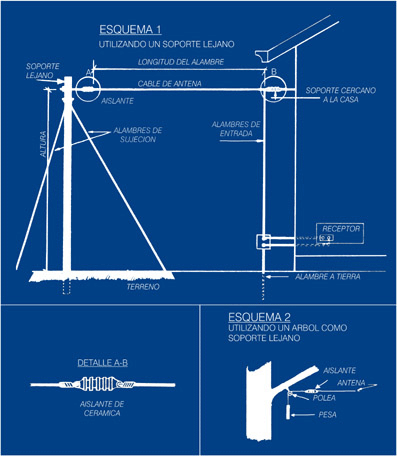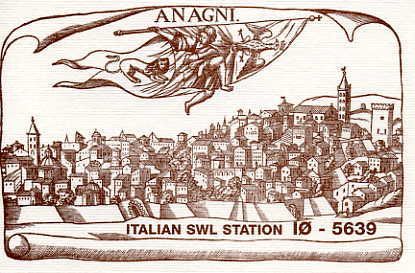Hi amigos amigos radioaficionados around the world and orbiting Planet Earth !Welcome to the weekend edition of your favorite radio hobby program, coming to you from sunny Havana, where summer weather is providing us with beautiful days for going to the beach !!! ITEM THREE: Listeners questions continue to come in via e-mail, postcards, letters and fax messages, and I have quite a backlog of them here waiting to be answered. a recent one from Chile, really surprised me, as normally the show is not heard so far South of Havana. But the use of 11760 kiloHertz with our omnidirectional 6 dB gain antenna explains why English speaking listeners from Chile are picking up Dxers Unlimited..ITEM FOUR: More about low cost , easy to build ham radio equipment, and at the end of the show, our exclusive and not copyrighted HF plus low band VHF from 30 to 120 megaHertz or a little higher propagation update and forecast.Stay tuned for more radio hobby related information, coming to you from Havana. .............Si amigos, yes my friends, you are listening to Radio Havana Cuba, the name of the show is Dxers Unlimited, and YES, we do QSL here one hundred percent, we do verify reception reports and we do it absolutely free of charge, as all short wave radio stations should do. Send your signal reports and comments about the program to inforhc@enet.cu, or VIA AIR MAIL to Arnie Coro, Radio Havana Cuba, Havana, Cuba, And NOW amigos , here is ASK ARNIE, LA NUMERO UNO !!!... THE most popular section of Dxers Unlimited, according to your e-mails, postcards and letters amigos . QUESTION number one for today: From listener Dwight in Maryland,USA, he wants to know why old radio magazines often mentioned the use of an accesory by the name of a “converter” that was connected ahead of short wave receivers to pick up the higher frequency bands. Well amigo Dwight, a converter is nothing but a complete front end of a radio receiver, it usually includes a radiofrequency amplifier stage, a mixer and a local oscillator. The RF stage in the case of the VHF bands used the best available vacuum tubes that at that time provided good gain and low noise, and the really good converters used a crystal controlled local injection oscillator. Even today, adding a homebrew converter ahead of a low cost receiver can provide outstanding results, especially with radios that lack front end selectivity. Not too long amog amigo Dwighty, I removed a lot of dust from a three vacuum tube six meter band converter that was in storage for many years. it required 6.3 volts filament voltage and 150 volts DC to operate. Powering it up from one of my workbench power supplies , I connected the more than 40 years old converter to a modern digital receiver, and was pleasently surprised when I could pick up several of the local VHF communications systems operating here around 49 megaHertz, using just a test lead from the multimeter as an antenna. Converters are no longer required for all practical purposes, as modern HF receivers are including extended tuning range up to the two meters amateur band. Anyway, for those of you like amigo Dwight that are interested in VHF converters, I may add that they are not too difficult to homebrew, especially if you use solid state devices. A typical more modern converter will use a high gain low noise MOSFET RF amplifier stage, a double balanced passive mixer and a bipolar transistor oscillator. It will be powered from 12 volts DC and when connected to even a low cost modern digital receiver, will turn the resultant combination into a rather nice VHF receiver , useful for monitoring 6 meters during the summer sporadic E season.Remember to tune set the receiver to scan from 50.0 to 50.3 megaHertz where most of the activity on 6 meters is concentrated around the world. QUESTION TWO, This one came from Bridgetown , Barbados, listener Alistair , who listens to our 11760 kiloHertz Caribbean edition, tells me in his e-mail that he wants to know more about the magnetic loops and why are they so useful when used at noisy locations. Well amigo Alistair , magnetic loops are first of all compact antennas, they are easy to turn around the compass to cancel noise sources, and above all, receive only magnetic loops can be built very easily and at low cost by anyone . My ultra simple HULA HOOP MAGNETIC LOOP is a perfect example of what I am talking about. It is built using a toy HULA HOOP as a “coil form “, a length of TV type coaxial cable, and areceiving type variable capacitor. It takes less than a couple of hours to complete, and most of your construction time will be used building the base where the HULA HOOP is fixed, so that it may be rotated. My HULA HOOP MAGNETIC LOOP provides excellent reception from 10 to 30 megaHertz, but it also works quite well with powerful station from 5 to 10 megaHertz. Amigo Alistair, I am sending direct to you via e-mail the complete , step by step building instructions for my HULA HOOP MAGNETIC LOOP, so that you can start building yours and then tell me also via e-mail how it performs at yourlocation.The HULA HOOP MAGNETIC LOOP is possibly one of the lowest cost high performance indoor antennas that exists, but it can also be used outdoors too, in which case you will have to install a remote tuning system to move the air spaced variable capacitor setting according to the operating frequency that you want to use. Let me add that the HULA HOOP MAGNETIC LOOP tunes quite sharply and it does require constant retuning of the air spaced variable capacitor with even a very slight change in frequency.BUT, peaking the antenna tuning for maximum signal is quite easy to do, and at the same time it provides ultra-sharp selectivity right at the antenna, that helps a lot to reduce unwanted noise and cross modulation problems caused by high powered stations that affect low priced receivers so badly.As a matter of fact, using my HULA HOOP MAGNETIC LOOP with a low cost digital receiver proved to be a very interesting experience, as the radio's performance was enhanced signficantly due to the extra selectivity at the front end provided by the magnetic loop antenna system.QUESTION THREE, yes, one extra today to reduce the backlog a bit, well question three, sent by listener Al in Vancouver , Canada, he asks me to describe in full, the design parameters for a low cost two element antenna for the 2 meters amateur band. Well amigo Al, using standard TV antenna elements aluminum rods, the small YAGI uses a split driven element of 980 millimeters, fed at the center with 50 ohm coaxial cable. The boom is made from 22 millimeters PVC pipe of the type used for water distribution , and the reflector element is 1002 millimeters long and located at exactly 51 centimeters from the driven element. This antenna has around 4 dB gain, a broad radiation pattern, is rugged and easy to build and will help you to access distant repeaters that can't be reached using the typical handie-talkie helically loaded antenna, popularly known as rubber ducky because they look like the tail of a duck wagging !!!Again, here are the dimensions for the 2 element low cost, easy to build YAGI for the two meters amateur band, the driven element is 980 millimeters long and split at the center, you may want tomake it a little shorter if you plan to use the antenna for the segment of two meters between 146 and 148 megaHertz.The boom of the antenna is made from 22 millimeters PVC pipe of the type used for high pressure water distribution, and is one meter long, so that you can hold the antenna to any support from the rear of the reflector element.The separation between the driven and the reflector element is 51 centimeters, and the length of the reflector element is 102 centimeters, that you can make a little shorter for the upper two megahertz of the two meter band.I feed this antenna with 50 ohm coaxial cable, and right after the feedpoint, I wind 6 turns of the coaxial cable to the boom of the antenna to make an RF choke.. the cable is then fed trough a hole in the boom to the rear of the antenna where it exits . I have made many of these antennas, and found out that they provide excellent performance, and when built using the above mentioned dimensions they are usually below 1.5 to 1 standing wave ratio even before any adjustments are made.They can be adjusted for almost perfect standing wave ratio by sliding the reflector element back and forth across the boom, and then leaving it permanently at the spot that provides the lowest SWR.Remember to use TV antenna rods or tubing, as the dimensions for my low cost two meter YAGI just described are based upon the diameter of the typical TV antenna elements.Try to tune the antenna for minimum SWR using a VHF standing wave ratio meter, but again, you can use the antenna directly without any adjustments without fear of high SWR, by just carefullymeasuring the elements .........And now amigos, as always, at the end of the program, here is Arnie Coro's Dxers Unlimited's HF propagation update and forecast. Solar flux is hovering around 70 and even lower, as no sunspots activity is presently recorded, and the A index was, as expected at a rather low level. No new active sunspot regions are detected at this moment. The present season of Sporadic E openings will continue to provide us with plentiful, surprising, interesting and challenging band openings some of them even reaching as high as the two meters or 144 megaHertz amateur band, so monitor the low band TV channels, both analog an digital to detect the Sporadic E openings as soon as possible for them. If you have a 10 meters or 6 meters band amateur radio rig, keep it on during the time that you are at home, keep them scanning from 28 to 28.5 megaHertz and from 50 to 50.3 megaHertz for signs of openings, that in many cases will be detected when automatic beacons start to come in as the opening starts . See you all at the mid week edition of the program and don' t forget to send me your radio hobby related questions, signal reports and comments .. send mail to inforhc@enet.cu or via air mail to Arnie Coro, Radio Havana Cuba, Havana, Cuba Posted by Arnaldo Coro at 9:56 PM
Dxers Unlimited
Dxers Unlimited is Arnie Coro's CO2KK Blog devoted to the promotion and development of the radio hobby. It focuses on the technical aspects of radio , and includes a twice weekly update on short wave and low band VHF propagation.Via Yimber Gaviria, Noticias de la Radiohttp://yimber-gaviria.blogspot.com
domingo, 12 de julio de 2009
Suscribirse a:
Enviar comentarios (Atom)


No hay comentarios:
Publicar un comentario